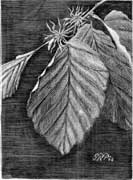|
 |
Earth Journal
by Gary Pendleton |
 Witch Hazel Witch Hazel
If you were to take a walk through the woods in early fall, you might be charmed by the discovery of yellow flowers blooming on a small tree so late in the year. If the odd encounter with a flower piqued your curiosity, you could discover a number of curious facts and interesting folklore.
Let’s say that, as part of your research, you took home a sprig. You might be setting yourself up for an encounter that could — depending on your temperament, beliefs and other influences — cause you to think that you had taken a cutting from a haunted species of silvaculture.
If you placed the inert twig, with its dormant seed capsules, in a warm spot such as a sunny window and then went about your business, you might be alarmed by seeds shooting from the capsules with enough velocity to travel more than 20 feet.
Then your state of mind might change from curiosity to vexation. What is the name of the fascinating plant whose spirited cutting shot its seeds across the room? Your field guide reports that your sample is aptly named witch hazel.
It would be natural to assume that the occult nature of the name is due to the tree’s startling seed-spitting ability, its oddly timed blooming period or even for the strange witches’ hats that form on the leaves. Yes, why not designate such a spirited plant with a bewitching name?
Actually, the tree was named for its resemblance to the European hazel tree, which, according to legend, could be used as a divining rod to find witches and water, even gold. The unusual aspects of the American witch hazel may have reinforced the newly arrived Europeans’ superstitious belief in the woods’ powers. The two species are not related, despite their resemblance.
Some trees have winged seeds; others rely on squirrels to disperse their seeds. The witch hazel uses physics. Just as the witch hazel is displaying its autumnal blossoms, the fruits from last year’s flowers are reaching maturity. The fruits are shiny brown seeds encased in hard capsules. The capsules shrink as they ripen, squeezing the seeds tight against the base of the capsule. When the capsule splits in two, the seed is forcibly ejected.
Witch hazel has medicinal qualities as well.
The aromatic leaves of the shrub were used by Native Americans to treat skin ailments and to staunch bleeding. European colonists also used it for similar purposes. Even today, bottles of Witch Hazel are sold in drugstores as an astringent to cool and cleanse the skin.
About the witches’ hats: They are cone-shaped bumps, or galls, that form on the leaves when insect parasites lay their eggs in leaf tissue. The larval insects produce chemicals to which the leaves react by developing tumor-like growths. These galls provide a place for the insects to grow as well as food to eat. Other species, notably oak and goldenrod, also produce galls — but only on witch hazel do they resemble witches’ hats.
|



 Witch Hazel
Witch Hazel